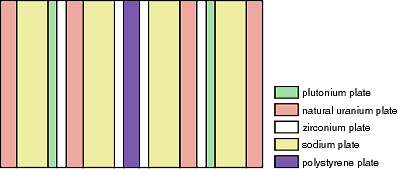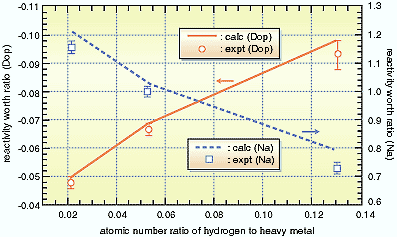New reactor concepts have been investigated to enhance the safety
margins for a metal or nitride fast reactor by adding a small amount
of moderator material to the core. With a softened neutron spectrum,
the reactivity characteristics of these cores can be improved; the Na
void effect can be reduced and the Doppler effect can be increased.
A series of mock-up experiments for a moderator-added metal fast reactor
was carried out at the FCA (Fast Critical Assembly) to obtain experimental
verification for these improvements of reactivity coefficients. Moderator
material, zirconium-hydride (ZrH), is simulated by the polystyrene (CH)
and zirconium (Zr) plates mounted in the central part of the test region
cell (Fig. 5-3). To evaluate the effect of the hydrogen contents on
reactivity characteristics, three kinds of mock-up cores were constructed.
Atomic number density ratios of hydrogen to heavy metal (H/HM) nuclide
of the test region cell of each core were set to be 0.02, 0.05, and
0.13 using three kinds of CH plates with different densities.
From Fig. 5-4, it is seen that the improvement of reactivity coefficients
was proved experimentally by adding a small amount of hydrogenous material
to the metal fueled fast reactor core. The measured data were analyzed
using the 70-group cross section set generated from the nuclear data
library JENDL-3.2 and the standard code system for the fast reactor
at JAERI. It was concluded from these analyses that the present code
system for fast reactor analysis predicts relatively well the measured
data of reactivity effect in the cores with various hydrogen contents,
and that this code system can be used for conceptual design study on
this type of fast reactor. |

